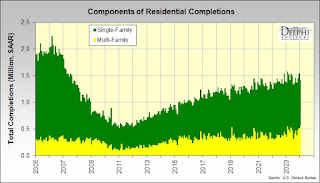In
its second estimate of 4Q2023 gross domestic product (GDP), the Bureau of Economic Analysis (BEA) revised the growth of the U.S. economy to a
seasonally adjusted and annualized rate (SAAR) of +3.21% (+3.3% expected), down
0.06 percentage point (PP) from the “advance” estimate (“4Qv1”) and -1.65PP from
3Q2023.
As with 4Qv1, all four groupings of GDP components -- personal consumption expenditures (PCE), private domestic investment (PDI), Net exports (NetX), and government consumption expenditures (GCE) -- contributed positively to the 4Q percent-change headline. “Compared to 3Q2023, the deceleration in real GDP in 4Q primarily reflected a downturn in private inventory investment and slowdowns in federal government spending, residential fixed investment, and consumer spending,” the BEA wrote, adding, “Imports decelerated.”
As
for details (billions of chained 2017 dollars; all relative to 4Qv1) --
PCE (+$5.1B):
*
Goods (-$7.6B). Spending on durable goods retreated ($7.2B), led by recreational
goods and vehicles (-$6.8B). A decline in nondurable goods (-$0.9B) was led by
clothing and footwear (-$2.9B).
*
Services (+$12.1B). Health care (+$16.5B) dominated the jump in household
consumption expenditures (+$16.7B).
PDI (-$12.3B):
*
Fixed investment (+$7.3B). Gains were balanced between nonresidential (+$3.4B) --
led by structures (+$6.6B) and intellectual property products (+$4.1B) but
partially offset by equipment (-$8.4B) -- and residential investment (+$3.4B).
*
Inventories (-$16.4B). Nonfarm inventories (-$14.2B) led the drop in this
category.
NetX (-$6.7B):
*
Exports (+$0.6B). Goods (+$0.4B) led the upward revision in this category.
*
Imports (-$7.3B). Goods (-$4.0B) held a narrow lead over services (-$3.1B).
Because imports are a subtraction in the calculation of GDP, the downward
revision nudged NetX up relative to 4Qv1.
GCE (+$8.9B):
*
Federal (-$0.9B). Nondefense consumption expenditures (+$-1.8B) led this
category.
*
State and local (+$9.6B). Gross investment (+$9.5B) dominated.
The BEA’s change in real final sales of domestic product -- which ignores inventories -- was revised to +3.49% (+0.28PP from 4Qv1), a level 0.11PP below the 3Q2023 estimate.
“This
all points to more domestic demand growth than previously thought and a hotter
economy in general,” said James
Knightley, chief international economist at ING.
The foregoing comments represent the general economic views and analysis of Delphi Advisors, and are provided solely for the purpose of information, instruction and discourse. They do not constitute a solicitation or recommendation regarding any investment.























































